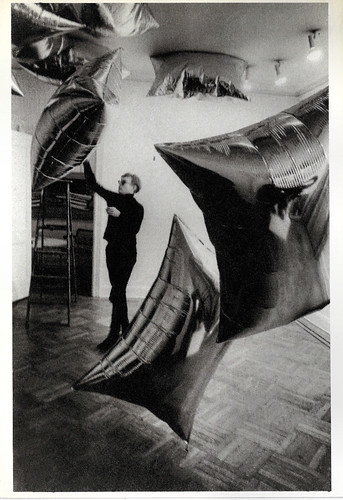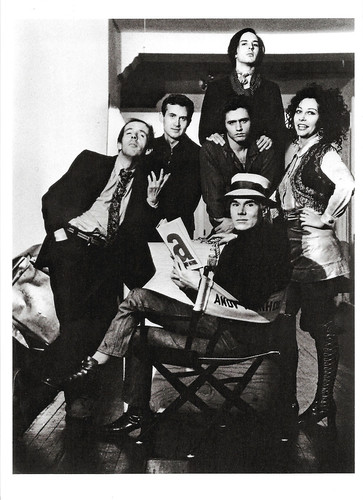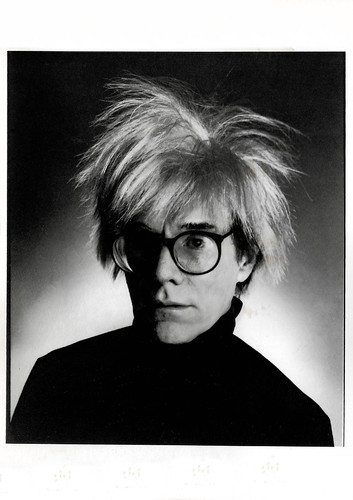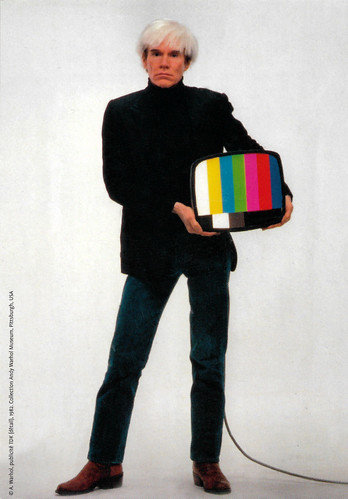
Dutch postcard by Art Unlimted, Amsterdam, no. F3135. Photo: Nat Finkelstein / Refuse Productions. Caption: Andy + movie camera, 1965.

French postcard in the Collection Magie Noire by Editions Hazan, Paris, 1994, no. 6434. Photo: Burt Glinn / Magnum Photos. Caption: Andy Warhol in the London sewers, 1965.
Art as mass-produced items
Andy Warhol was born Andrew Warhola in 1928 in Pittsburgh, USA. His parents were Ondrej (Andrew) Varhola and Julia Zavackyová Varholová, ethnic Lemko immigrants from the village of Miková in the Austria-Hungary Empire (now Slovakia). Ondrej, whose surname was originally written as Varhola, changed the spelling to Warhola when he emigrated to the US. He worked as a construction worker and later as a coal miner.
His father, who travelled much on business trips, died when Andy was 13. During his teenage years, he suffered from several nervous breakdowns. He showed artistic talent early on and went to study applied art in Pittsburgh at the Carnegie Institute of Technology, now Carnegie Mellon University. There, he stood out by drawing two self-portraits showing him picking his nose ('Upper Torso Boy Picking Nose' and 'Full Figure Boy Picking Nose'). In 1949, Andy graduated and dropped the letter 'a' from his last name.
Warhol moved to New York, where he met Tina Fredericks, the art editor of Glamour Magazine. Warhol's early jobs were doing drawings for Glamour, such as the 'Success is a Job in New York' and women's shoes. He also drew advertising for various magazines, including Vogue, and Harper's Bazaar, book jackets, and holiday greeting cards.
In 1952, his first solo exhibition was held at the Hugo Gallery in New York, of drawings to illustrate stories by Truman Capote. He started illustrating books, beginning with Amy Vanderbilt's 'Complete Book of Etiquette'. In 1956, he was included in his first group exhibition, 'Recent Drawings USA', held at the Museum of Modern Art, New York. By 1959, he was a successful advertising designer with an average annual income of $65000 and almost annual medals and other professional awards.
In 1960, Warhol began to make his first paintings. They were based on comic strips in the likes of Dick Tracy, Popeye, and Superman. In the following years, Warhol started painting famous American products like Campbell's soup cans and Coca-Cola bottles in large formats. He managed to interest the influential gallery owner and art collector Leo Castelli in his work. He started using the silk-screen technique, not merely to create art using everyday commercial mass-produced items as his motif but to create even his own art as mass-produced items. Warhol preferred to become an emotionless machine.
He set himself up as chief of a team of art workers who were engaged in making screen prints, films, books and magazines. This team operated in a studio near Union Square in New York. The studio was called the Factory because it actually housed a production line of paintings. The original Factory was located in an old cap factory at 231 East 47th street (fourth floor). This studio grew into a meeting place for artists, gays, transvestites, junkies and photographic models. Anyone with any artistic pretensions was welcome there.

West German postcard in the 161 Andy Warhol series by Gebr. König Postkartenverlag, Köln, no. 161/4 (4 of 10), 1989. Illustration: Andy Warhol. Caption: Hedy Lamarr, 1962.

Dutch postcard by Art Unlimted, Amsterdam, no. B 1614. Photo: Nat Finkelstein, 1966.
A banana with a peel
After a few years, Andy Warhol moved his entourage to an office building across the street; 33 Union street West (sixth floor). This second Factory was called the Office by Warhol himself because it housed not only a studio but also the editorial office of Interview magazine, founded by Warhol. Warhol became known worldwide during the Factory years with his screen prints. Warhol's oeuvre largely draws on American popular culture. He made screen prints of any subject that lent itself to it. He painted and drew banknotes, cartoon images, food, women's shoes, celebrities and everyday objects. For him, these motifs represented American cultural values.
Paul Morrisey managed to persuade Warhol to become the manager of a rock band. It would be a commercial success if Warhol combined his talent for generating media attention with a sensational rock group. Warhol was not immediately enthusiastic but after Morrisey's insistence, he relented. Morrisey had seen The Velvet Underground perform at Cafe Bizarre. After Warhol went to see, he was immediately excited. He saw a group standing with good looks who, while tourists sat drinking, sang about Heroine and SM.
Warhol made the Velvet Underground part of his multimedia show 'Exploding Plastic Inevatible'. He also produced The Velvet Underground's first album with Nico. He essentially lent his name to their work and observed them in the recording studio, while Lou Reed and later Tom Wilson mostly called the shots. The cover of the band's first album was Warhol's design: a banana with a peel that was actually a peelable sticker.
On 3 June 1968, Valerie Solanas, a radical feminist author who hung around the Factory from time to time, turned up at the studio and shot Warhol and art critic Mario Amaya. Solanas had been rejected earlier that day at the Factory after she had requested the return of a script she had given Warhol for inspection. The script had apparently gone missing. Warhol was badly injured in the shooting and was even declared clinically dead in the hospital. He suffered the physical effects of the attack for the rest of his life and had to wear a corset to support his lower abdomen.
The shooting had a major after-effect on Warhol's life and his art. The Factory became more tightly shielded and for many, this event marked the end of the Factory's wild years. That same day, Solanas turned herself in to the police and was arrested. Her explanation for this crime was that Warhol had become too much of an influence on her life. This incident is the subject of the film, I Shot Andy Warhol (Mary Harron, 1996).

Dutch postcard by Art Unlimted, Amsterdam, no. B 1609. Photo: Nat Finkelstein, 1966. Caption: Andy Warhol, white wall.

Swiss postcard by CVB Publishers / Filmwelt / News Productions, no. 57279. Photo: David Gahr / Collection Cinémathèque Suisse, Lausanne. Andy Warhol with Taylor Mead, Paul Morrissey (?), Fred Hughes, Gerard Malanga and Ultra Violet, pose for a portrait to publicize Warhol's 1968 book 'a' in December 1968 at The Factory at 33 Union Square West in New York City, New York.
Sleep, Kiss, Blow-Job and Eat
Between 1963 and 1968, Andy Warhol was a prolific filmmaker. He made more than one hundred and sixty films, 60 of which are accessible. The films share similarities with his paintings, which also feature many repetitions and subtle variations of images. In the 1970s, Warhol banned the distribution of his films, but in the 1980s, after much insistence, he gave permission to restore the films. In many of his films, the usual projection speed was reduced from 24 frames to 16 frames per second. This is slightly different from usual slow-motion, where the film is actually shot at a higher speed and played back at normal speed. Warhol's technique gives the individual images more emphasis.
One of his most famous films, and also his first, Sleep (1963), shows for eight hours a sleeping man, John Giorno, with whom he had a relationship. Warhol filmed for about three hours each time until the sun rose at five in the morning. Filming took a month. The film Kiss (1963) shows close-ups of kissing couples for 55 minutes. Blow Job (1963) is a continuous close-up of the face of a man (DeVeren Bookwalter) being orally satisfied off-screen. According to Warhol's later assistant, Gerard Malanga, the invisible role featured poet and filmmaker Willard Maas, although Warhol gave a different reading on this in his memoir 'Popism'.
Warhol met Malanga in 1964, and they made Tarzan and Jane Regained... Sort of (1964). That year, Warhol also made a 99-minute portrait of the Metropolitan Museum of Art's famous curator Henry Geldzahler. During the filming, Warhol simply walked away. The film clearly shows how Geldzahler was bored and uncomfortable by the camera. By the end of the film, he collapsed completely. Also from 1964 is the film Eat, featuring Warhol's colleague and friend Robert Indiana, who is eating a mushroom very sedately and in a close-up. Another film, Empire (1964), consists of an eight-hour shot of the Empire State Building in New York at dusk.
Warhol's role-playing film Vinyl (1965) is an adaptation of the dystopian Anthony Burgess novel 'A Clockwork Orange'. Further films depict impromptu encounters with Factory hustlers such as Brigid Berlin, Viva, Edie Sedgwick, Candy Darling, Holly Woodlawn, Ondine, Nico and Jackie Curtis. In the film Camp, legendary artist Jack Smith appears within the subculture. Many famous visitors to the Factory were put in front of the camera between 1963 and 1966, and filmed for 2 minutes and 45 seconds, the length of the standard roll of film. Usually, these were static portraits. By running the films more slowly, the expressions of the faces are greatly magnified. These shots resulted in about 500 films, called Screentests by Warhol. Among those portrayed are film star Dennis Hopper and pop stars Lou Reed and Bob Dylan. The films were edited in various compositions and shown at Warhol exhibitions and in movie houses.
Warhol's unorthodox approach is exemplified by Kitchen (1965). The actors do not know their roles by heart, but the screenplay is hidden in various places on the set. The scriptwriter whispers lines of dialogue from outside the frame. Snapshots are taken during filming. The set designer appears on the screen. Dialogue is drowned out by the sound of a mixer. There are long periods when nothing happens. There are two pairs of characters with the same names. Warhol was not interested in auctorial control but shifted the burden from the director to the actors and the shooting crew. He showed little interest in story intrigue, which he considered old-fashioned, or technical aspects of filmmaking. Warhol wanted to explore the borders between feigned action and the more authentic behaviour of non-actors, which is why he kept the camera running constantly: he didn't want to miss anything.
In the summer of 1965, Andy Warhol met Paul Morrissey, who became his advisor and collaborator. Warhol's most successful film was Chelsea Girls (1966). The film was innovative as it consisted of two simultaneously projected 16-mm rolls of film with divergent narratives. From the projection booth, the sound level for one film was raised to clarify that story while it was lowered for the other, after which the reels were reversed. Chelsea Girls became the first underground film to be shown at a commercial theatre. Warhol also used this method of doubling the image in his screen prints of the early 1960s. Other important films include My Hustler (1965) and Lonesome Cowboys (1968), a homoerotic pseudo-Western. Blue Movie (1969), a film in which Warhol's 'superstar' Viva has sex with a man (Louis Waldon) for 33 minutes, was Warhol's last film of his own. After the film caused a scandal because of its liberal approach to sexuality, Viva managed to block its public screening for a long time. The film was not shown again in New York until 2005, for the first time in 30 years.

American postcard by Fotofolio, no. P318. Photo: Christopher Makos. Caption: Andy Warhol, 1978. Kissing John Lennon at the Factory.

American postcard by Fotofolio, New York, NY, no. P310. Photo: Christopher Makos, 1986. Caption: For Andy, who taught me how to see.
Flesh, Trash, Heat and Bad
Compared to Andy Warhol's provocative work in the 1960s, the 1970s were artistically less productive, although Warhol became much more businesslike. He retired as a film director and left filmmaking to Paul Morrissey. The latter steered the approach to Warhol films more and more in the direction of ordinary B-movies with a clear narrative, for example, Flesh (1968), Trash (1970) and Heat (1972). These films, as well as the later films Flesh for Frankenstein (Paul Morrissey, Antonio Margheriti, 1973) and Sangue per Dracula/Blood for Dracula (Paul Morrissey, 1974), were much more mainstream than anything Warhol had ever made himself as a director. The star of these films was Joe Dallesandro, who was actually a Morrissey star rather than a true Andy Warhol superstar. Another film that caused a lot of furore as a Warhol film was Bad (1977), starring Carroll Baker and Perry King. This film was actually directed by Jed Johnson. To increase the success of the later films, all of Warhol's earlier avant-garde films were withdrawn from circulation around 1972.
Warhol founded Interview magazine in 1969. He resumed painting in 1972, although it was primarily celebrity portraits. According to his assistant during his later years, Bob Colacello, Warhol mainly sought out wealthy people from whom he could secure portrait commissions, such as Mick Jagger, Liza Minnelli, John Lennon, Diana Ross, Brigitte Bardot and Michael Jackson, as well as lesser-known bank executives and collectors. In 1975, he published his book 'The Philosophy of Andy Warhol', in which he explained his down-to-earth ideas about art and life.
Incidentally, he appeared in films and TV shows. When guesting on The Love Boat (1977), he was nervous about the experience and turned to his castmate Marion Ross, who calmed him down and offered some advice on how to act. In 1976, Warhol began a daily routine. Every morning at 9 am, he would call Pat Hackett, whom he had hired to keep track of his expenses. What was initially supposed to be just a morning bookkeeping session soon turned into an extremely intimate exchange of private experiences between the two of them. Warhol, who was "addicted to the phone anyway", told Hackett about the rather delicate details of the New York scene and celebrities, a subject that had interested him since childhood. Like his time capsules, the conversations were for capturing a picture of the times. After his death, Hackett released some of these notes in the book 'The Andy Warhol Diaries'. In 2022, this book was made into a Netflix documentary.
Andy Warhol worked for several years with Jean-Michel Basquiat a young artist in whom he recognised much of himself. The collaboration was equal, Warhol was past his prime and Basquiat had already established his name. This equality allowed them to collaborate on some 140 works, some of which were exhibited in a duo exhibition at the New York gallery Tony Shafrazi in 1985. The ensuing New York Times review made Basquiat Warhol's mascot after which their collaboration and also their friendship cooled.
Andy Warhol died in 1987 at the age of 58 in New York. He was recovering from a routine operation on his gallbladder when he died of cardiac arrest in his sleep. Hospital staff had administered sleeping pills to him after the operation and had not sufficiently monitored his well-being. Consequently, lawyers for Warhol's next of kin sued the hospital for negligence. Warhol constantly delayed medical treatment because he was afraid of hospitals and disliked doctors. Warhol was buried at St John the Baptist Byzantine Catholic Cemetery in Bethel Park, south of Pittsburgh. Yoko Ono was among those who gave a farewell address at his funeral. International auction house Sotheby's took nine days to auction off Warhol's immense collection of art and 'knickknacks'. The gross proceeds of this auction were about US$20 million. In 1990, Lou Reed and John Cale made a CD album called 'Songs for Drella' as a tribute to Warhol with 15 songs about Warhol's life.

British postcard by London Cardguide LTD, London. Photo: Ewa Rudling.

French freecard by Descartes / Actioncarbone, 2009, for the exhibition 'Warhol TV' in La Maison Rouge, Paris. Photo: Andy Warhol, publicity TDK (Detail). Collection: Andy Warhol Museum, Pittsburgh, USA.
Sources: Herman Hou (IMDb), Michael Brooke (IMDb), Wikipedia (Dutch) and IMDb.
No comments:
Post a Comment